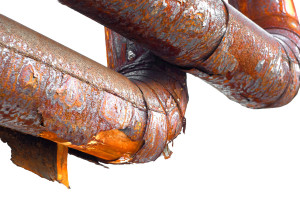If it aint broke dont f..ool yourself
 Could something be clogged up that looks all good on the surface? A process? A procedure? A system?
Could something be clogged up that looks all good on the surface? A process? A procedure? A system?
Taking a hacksaw to a steel pipe led to an unexpected benefit. Fixing up an old property triggered the realisation that making things better is often obscured by ignorance. The lack of knowledge, time, money or energy makes the phrase “If it aint broke don’t fix it” feel really natural and right. But that is not always the best advice.
There is of course a reason this saying came about. But did you know the popularisation of the saying was in relation to government inefficiency? In 1977 Bert Lance, a budget official during the Carter administration is attributed to coining the phrase. In its full context he was making a commentary that the government could save millions if it didn’t keep “Fixing things that aren’t broken and not fixing things that are broken.”
That makes total sense if ineffective things are happening – but what if everything is seemingly on track? We can afford to leave stones unturned but at what unknown cost?
Get someone else who knows what they are doing to help determine if something is “broke”.
We are patching up a house between tenants with a laundry list of fixes that feels never ending. A beautiful old Queenslander of 1920′s construction, she has suffered natural deterioration and a previous tenant that didn’t care for her much.
Being a rental we want to get it back onto the market as quickly as possible so the constraints of time, money and energy are felt very acutely. We only have weekends available to get a few things done and every week that goes by is another week without rent. In hopes to attract a higher calibre tenant we want things to be nice. Not being the most ‘handy’ of people the lack of fixit know how further compounds the feeling that we should only work on what is most obviously broken.
We were very lucky this weekend to have a family friend available to help us. He is of the disappearing generalist breed of tradesman who is a plumber, electrician, carpenter, builder and air conditioning repair man rolled into one.
Before I could work out how to adjust a wrench he’d unbolted an old toilet and was starting to get ready to install a new one. We ventured under the house (it is raised on stumps as is the Queenslander style) and he took one look up at the water loop, handed me a hacksaw and said in a gentle hungarian accent “this is horrible, cut here, here, there and there”
The house was originally built in another location but moved on the back of a truck during the 1970′s. When it was set down at its current address, a new copper water pipe lead-in was attached to the already deteriorating original steel plumbing.
I absorbed what was ‘horrible’ about the plumbing by following his finger. I could now see that over the years the pipes had deteriorated and had been taped up over and over again. Crooked bends and joints ominously looked like they could fly apart at any time.
Upstairs the water was flowing fine. Taps turned on and off and water trickled out. There wasn’t obvious leaks. There didn’t seem to be anything to fix.
This was going to be a lot of work! Was it worth it? Was it worth disrupting something that worked ok?
Status quo, you know, that is Latin for the mess we’re in
- Ronald Reagan
There can be unexpected benefits to fixing something that doesn’t look “broke”.
As I sweated my way through the steel pipe I was treated to a sludgy brown trickle from within. With a satisfying clang the large runs of steel pipe fell to the ground. When I picked one up and looked at a cross section I could see that more than half of the diameter of the pipe was clogged with junk from over 90+ years of wear and use.
Our friend spent the next few hours welding and clamping fresh new copper runs into place. I laboured back and forth out front to the water mains to turn things on and off, testing for leaks.
He explained as he went why he was diversifying and increasing the amount of runs to improve the experience in the house. Things like the shower not being interrupted by a toilet flush. Small touches he was adamant improved the quality of life for someone living in the house. When he was done I ventured to test the amenities.
Upstairs the water was flowing fine. Taps turned on and off and water trickled gushed out. The water pressure had tripled. I hadn’t even realised how bad the water pressure was until I saw what was possible with these new pipes.
Effective. Simple – obvious – the best things always are.
As I looked at the tattered mess of steel on the ground I knew we’d done the right thing. There won’t be any weekend plumber call outs at outrageous fees because that old taped joined gave way. There won’t be a screaming mother in the shower when dad fills up the kitchen sink.
The work also meant we could install a new external tap to make washing a car in the driveway easier and a new hand basin in the toilet where plumbing couldn’t reach before. It fixed things we didn’t even know were broken.
We were lucky to have someone to come look at what we had and have the domain experience to know it could be better. Someone who knew what we didn’t know.
I’m not advocating for change for changes sake – there has to be an improvement. I do believe that a process that works fine shouldn’t be exempt from critical examination in the quest for improvement. We almost never get it “right” the first time, or usually the second of third, even when there is a consistent result.
Have you fixed something that wasn’t broke and was surprised by the improvement?





